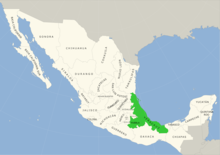Symphyotrichum schaffneri
| Symphyotrichum schaffneri | |
|---|---|

| |
| Scientific classification | |
| Kingdom: | Plantae |
| Clade: | Tracheophytes |
| Clade: | Angiosperms |
| Clade: | Eudicots |
| Clade: | Asterids |
| Order: | Asterales |
| Family: | Asteraceae |
| Tribe: | Astereae |
| Subtribe: | Symphyotrichinae |
| Genus: | Symphyotrichum |
| Subgenus: | Symphyotrichum subg. Symphyotrichum |
| Section: | Symphyotrichum sect. Symphyotrichum |
| Species: | S. schaffneri
|
| Binomial name | |
| Symphyotrichum schaffneri | |

| |
| Native distribution[2] | |
| Synonyms[1] | |
| |
Symphyotrichum schaffneri (formerly Aster schaffneri) is a perennial, herbaceous species of flowering plant in the family Asteraceae native to the states of Puebla and Veracruz, Mexico.[3]
Description[]
S. schaffneri, a perennial and herbaceous plant with a creeping rhizome system, reaches heights of 30–100 centimeters (12–39 inches) on striated slender stems with hairs in lines below and more uniformly hairy lines higher up. Branching occurs in the upper portions at 15–45° angles that ascend or sometimes arch if long enough.[3]
Leaves[]
The leaves have a prominent middle vein with fine, reticulate veins surrounding it.[a] They are hairless on top with soft hairs on the back sides, usually just on the midvein or scattered. Leaves clasp the stem up to halfway around it. The stem leaves are 4–10 cm (1+1⁄2–4 in) long and 1–2 cm (2⁄5–4⁄5 in) wide, with basal (bottom) leaves smaller at 18–25 mm (3⁄4–1 in).[3]
Flowers[]
On the outside the flower heads of all members of the family Asteraceae are small bracts that look like scales. These are called phyllaries, and together they form the involucre that protects the individual flowers in the head before they open.[b][4] The involucre of each flower head of S. schaffneri is funnel-shaped or half-spherical and 4.5–7 mm (1⁄5–3⁄10 in) long. There are 25–45 phyllaries in about four graduated series with the inner phyllaries about two to three times longer than the outer phyllaries. There are 17–24 white ray florets length 4.5–7 mm (1⁄5–3⁄10 in) (sometimes up to 10 mm (2⁄5 in)) long, with 11–26 yellow then pink disk florets.[3]
Taxonomy[]
The species was formally described in 1986 as Aster schaffneri Schultz-Bip. ex Sundberg & A.G.Jones by American botanists and Almut Gitter Jones. The specimens analyzed had been collected in 1855, stored, and labeled "Aster schaffneri Schultz-Bip." but were concluded by Sundberg and Jones never to have been formally described.[2] It had been named for J.G. Schaffner,[2] German plant collector and pharmacist Johann Wilhelm Schaffner, later known as J.Guillermo Schaffner.[5]
Notes[]
Citations[]
- ^ a b POWO 2021.
- ^ a b c Sundberg & Jones 1986, p. 173.
- ^ a b c d Sundberg & Jones 1986, p. 175.
- ^ Morhardt & Morhardt 2004, p. 29.
- ^ Stafleu & Cowan 1979, p. 113.
References[]
- Morhardt, S.; Morhardt, E. (2004). California desert flowers: an introduction to families, genera, and species. Berkeley: University of California Press. ISBN 0-52024-003-0.
- POWO (2021). "Symphyotrichum schaffneri (S.D.Sundb. & A.G.Jones) G.L.Nesom". Plants of the World Online. Royal Botanic Gardens, Kew. Retrieved 19 July 2021.
- ; Jones, A.G. (1986). "Two new taxa of Aster (Asteraceae) from Mexico". Bulletin of the Torrey Botanical Club. 113 (2): 173–177. doi:10.2307/2995942. JSTOR 2995942. Retrieved 15 August 2021.
- Stafleu, F.A.; Cowan, R.S. (1979). Taxonomic Literature : a Selective Guide to Botanical Publications and Collections with Dates, Commentaries and Types. 2 (2nd ed.). Utrecht: Bohn, Scheltema & Holkema. Retrieved 1 September 2021 – via Biodiversity Heritage Library.
- Symphyotrichum
- Flora of Mexico
- Plants described in 1986
- Taxa named by Scott D. Sundberg
- Taxa named by Almut Gitter Jones